Auschwitz II - Birkenau |
||
|
|
The photo above, taken in May 1944, shows a mother, who is capable of work, being directed by an SS officer towards the Krema II gas chamber because she has refused to part with her baby. During the selection process, mothers were asked to hand over their babies to the elderly women, but those who refused were sent to the gas chamber. In a recently published book entitled "Absence of Closure," Dr. Gustav Schonfeld wrote about what happened after his family was transported to Auschwitz from the town of Munkacs in Czechoslovakia, which became part of Hungary after Czechoslovakia was invaded by the Hungarian army in 1938. Schonfeld wrote that, during the selection process at Birkenau, his father ran ahead in the line to see what was going on, and then ran back to tell his wife that she should let her mother hold her baby, and she should tell the selections officer that she was a nurse. This saved his mother's life because if she had not handed her baby over to her mother, she too would have been sent to the gas chamber. According to Dr. Schonfeld, Dr. Joseph Mengele told his mother not to worry, that she would see her baby later. When his mother frantically asked Dr. Mengele where her baby was, she was told to look at the camp's smokestacks. Dr. Schonfeld wrote that his mother never forgave herself for giving her baby to her mother. According to Dr. Ella Lingens, a non-Jewish political prisoner at Auschwitz-Birkenau, some of the SS doctors considered the work of doing selections to be the most stressful of their camp duties. As quoted in the book entitled "Mengele, the Complete Story," Dr. Lingens said the following: Some like Werner Rhöde who hated his work, and Hans König who was deeply disgusted by the job, had to get drunk before they appeared on the ramp. Only two doctors performed the selections without any stimulants of any kind: Dr. Josef Mengele and Dr. Fritz Klein. Dr. Mengele was particularly cold and cynical. The photo below, from the Auschwitz Album, shows Hungarian Jews who are facing the Central Sauna building at Birkenau where incoming prisoners were processed; in the background are the clothing warehouse buildings in the area of Birkenau known as "Canada," which was directly across from the Sauna. According to information given at the Yad Vashem Museum, where the pictures from the original Auschwitz Album are kept, these Jews are waiting for their turn in the gas chamber in Krema IV, which is a short distance north of the Central Sauna. 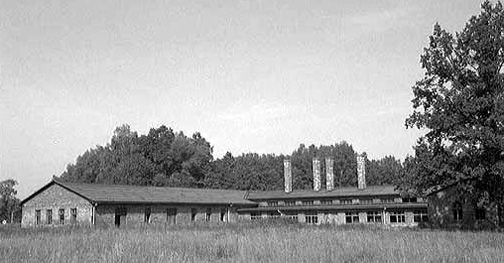 The gas chambers in the Birkenau camp were disguised as shower rooms. The Red Cross inspected the shower facilities at Auschwitz-Birkenau and noticed that some of the fixtures were in need of repair, but they never suspected that some of the shower rooms were actually gas chambers with fake shower heads. The Red Cross report, Vol. III p. 594, stated the following about the facilities at Auschwitz: "Not only the washing places, but installations for baths, showers and laundry were inspected by the delegates. They had often to take action to have fixtures made less primitive, and to get them repaired or enlarged." The photo below shows a woman who is being restrained by three Jewish men at the Birkenau camp; she is upset because she was separated from her family members during the selection process. In the background is what looks like the Krema IV building; an SS officer is walking toward the victims. Krema IV is shown in the second photo below. 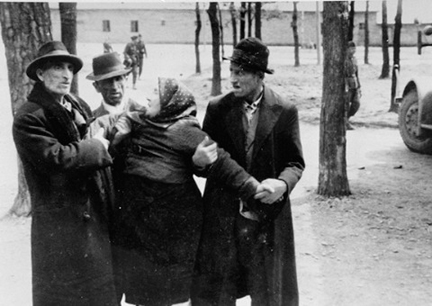 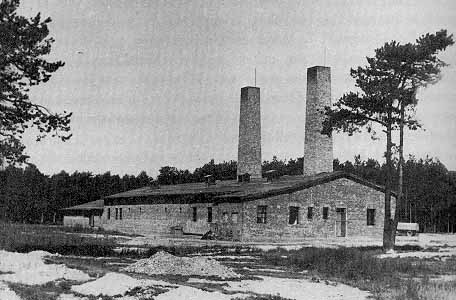  The women and children in the photo above have been selected to die in the gas chamber. They are walking west down the main camp road, past the Krema III gas chamber in the background. They are looking toward Krema II, which is on the left side of the main camp road. In 1944, the main camp road intersected a north-south road at the western end of the Birkenau camp; the north-south road led to the Central Sauna where those who were selected for labor took a shower before being assigned to their barracks. A short distance beyond the Sauna were the fake shower rooms in Krema IV and Krema V, where those unfit for work were gassed. The intersection of the two roads can no longer be seen today because the International Monument at Birkenau was built in that location. In 1944, the main camp road went all the way to the western end of the camp and continued outside the camp. Today visitors must turn north at the ruins of Krema III to get to the north-south road to the Sauna and the ruins of Krema IV and Krema V. In a 2006 interview with Don Moore, a writer with the Sun-Herald, Holocaust survivor William Schick told about how he narrowly escaped being gassed at Birkenau on two separate occasions. Schick was a Czech Jew who was first sent to the Theresienstadt ghetto before being transferred to the Czech family camp at Birkenau. As a prisoner in the Czech family camp, Schick played in the soccer matches at Birkenau. The soccer field was located near the Krema III gas chamber. Regarding the liquidation of the Czech family camp in section BIIb, the following quote is from Don Moore's article in the Sun-Herald: "They told everyone in Camp B2B we were going to be sent to Germany as slave laborers, but we had to clean up and shower first and we'd be issued new uniforms," he said. "When we reached what the guards said were the 'showers' there was a commotion going on. I could speak a little German and I heard the guards say something was 'kaput.'" He learned later the apparatus that filled the showers with poison gas was 'kaput.' The prisoners from B2B had escaped death. They were marched back to their barracks. Three days later they were marched back to the gas chambers to die. "We were just about to go into the gas chambers once more and there was another commotion out front. "A train with 10,000 Jews from Hungry had just arrived. They had no place to put them. We were sent back to our barracks once again. They marched all 10,000 Hungarian Jews into the three gas chambers at Auschwitz and killed them all in 24 hours." On October 8, 1944, a total of 500 prisoners were taken from Auschwitz II (Birkenau) to the Taucha Kommando, which belonged to the Buchenwald camp, according to a footnote in the book "Triumph of Hope," written by Auschwitz survivor Ruth Elias. Ruth Elias was among these 500 prisoners; in her book, Ruth Elias wrote the following: We were taken to the ramp, where cattle cars were waiting for us. To our surprise we saw that men wearing the striped prison clothes were being loaded into box cars at the rear of the train. A prisoner working at the ramp told me that these men had come from Theresienstadt. I couldn't believe it; I thought that all of them had been gassed. In the book written by Ruth Elias, entitled "Triumph of Hope," the following sequence of events in the liquidation of the Czech family camp is given: On July 2, 1944, Dr. Josef Mengele made a selection in the Czech family camp. He selected 1,000 male prisoners whom he considered fit for work, and on July 7, they were transported out of Birkenau. Women who were considered fit for work, including Ruth Elias who was pregnant, were transferred from the Czech family camp to the women's camp at Birkenau. On July 11, 1944, the liquidation of the Czech family camp began when 3,000 prisoners were sent to the gas chamber. The next day, 4,000 more prisoners were sent to the gas chamber, after being selected by Dr. Mengele, and the family camp ceased to exist. On July 14, the women who had been selected for work, including Ruth Elias, were sent to Hamburg or to the Stutthof concentration camp near the city formerly known as Danzig. Dr. Susan Cernyak-Spatz was 18 years old when she was sent from Czechoslovakia to the Birkenau camp in 1943 and tattooed with the number 34042 on her left arm. In a newspaper article in the Salisbury Post, Scott Jenkins reported on a talk that Cernyak-Spatz gave to sixth-graders at Corriher-Lipe Middle School in May 2000. She stressed to the Corriher-Lipe students that the Holocaust was not a single event, but an efficiently conceived and executed process that began "the minute Adolf Hitler came to power" as Germany's dictator in 1933. The following quote is from the newspaper article by Scott Jenkins in the Salisbury Post: So fierce was Hitler's hatred, trains carrying Jews to the death camps were given priority even over troop trains carrying soldiers to battle, Cernyak-Spatz said. When she stepped off the train and onto the platform at Birkenau, the results assaulted her senses. "The first thing you noticed was an absolutely incredible stink," she said. The noxious, sickly sweet odor hung in the air with a dusky vapor billowing from smokestacks and staining the distant sky, she said. Then, the selection began. The Nazis separated families, those who could work to one side, those who couldn't to another. The second group loaded onto trucks. The women on the trucks asked where they were going. Don't worry the drivers told them, you will be reunited with your families. After a nice hot shower. "Then they took them directly in the direction of that smoke," Cernyak-Spatz said. Soon, those who survived learned what burned in those buildings. Guards led prisoners into the large buildings, told them to take off their clothes, hang them on hooks. And remember, tie your shoe laces together, they said, so you don't lose a shoe. The Nazis had told Jews to dress in their warmest clothes for the journey to the "work" camps, Cernyak-Spatz said. After the gas chambers, they gathered those clothes for their own use. For the years during the war, "that is how the whole German nation was clothed ... in the clothing and property of dead Jews," she said. 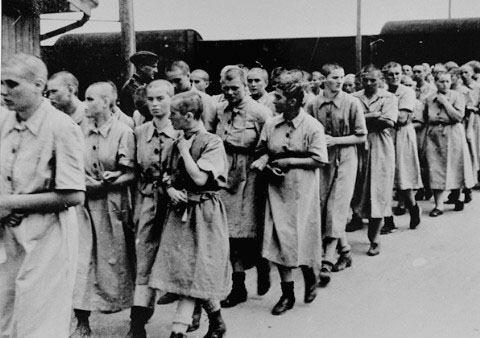 Cernyak said that the Nazis took the clothes of the prisoners and gave them the uniforms of dead Russian soldiers to wear; the uniforms had bullet holes in them and were spattered with blood. She described how the prisoners were given only one bowl, with no eating utensils, and they had to use the bowl for both eating and drinking, as well as for eliminating their own bodily waste when the guards would not let them use a bucket at night. According to Cernyak-Spatz, the prisoners dumped the waste beside their bunks because they were not allowed to go outside the barracks at night. Cernyak-Spatz said that the prisoners had to line up outside their barracks every day for a new selection. Sick prisoners were sent to the gas chamber. According to Cernyak-Spatz, between 1,500 and 2,000 Jews died in the gas chambers at Birkenau every day and some of them went willingly. Cernyak-Spatz said that she survived the selections when she had typhoid fever because other women carried her when she couldn't walk. She had to keep her eyes wide open, because the Nazis looked for "apathetic eyes" at the selections. She also survived scabies, hepatitis, scarlet fever and probably other illnesses, according to her story, as told to the sixth-grade students. After she met a woman in her barracks who worked inside the camp's administrative building, Cernyak-Spatz was able to get an office job. She was given a new set of clothes once a month and allowed to take a shower a couple of times a week because the German officers did not want to be exposed to the lice that caused rampant disease in the camp. She was also spared from appearing at the selections every morning during the two years that she worked in administration office from January 1943 to January 1945. 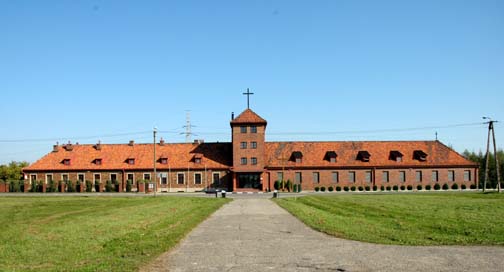 According to the article in the Salisbury Post, Cernyak-Spatz had lived with her family in Vienna, Austria until 1938, when the Nazis marched into the city. The invading army "mercilessly beat and mistreated the Jews," she said. Eventually, the Germans told the Jews that they had to leave immediately. The family fled, leaving behind almost everything they owned - from the clothes in their closets to the food in their refrigerator. They moved to Prague, Czechoslovakia, but the Germans soon invaded and the Jews were robbed of all their property, according to Cernyak-Spatz, as told to the students. Unlike most of the Jews in Czechoslovakia, Cernyak-Spatz was not sent to Theresienstadt and then to the family camp at Birkenau. When the Birkenau camp was abandoned on January 18, 1945, the camp Commandant allowed the prisoners to take the warmest clothing they could find from the warehouse; this was how Cernyak-Spatz and 500 other prisoners survived the 50-kilometer death march out of the camp to the German border. Cernyak-Spatz was then sent to the Sachsenhausen concentration camp near Berlin, where she was forced to go on another death march when the camp was evacuated in April 1945; she was liberated from that march by Allied soldiers. Elaine Geller was sent to Auschwitz-Birkenau at the age of 4, after seeing her mother and grandparents shot right in front of her. Geller survived and now gives frequent lectures about the Holocaust. Geller told an audience in Granite Hills, CA on March 4, 2009 that she never officially got any food while she was in the Birkenau camp, since she was a child and because of her age, she wasn't counted at Auschwitz; Geller survived only because her aunt shared her food. She did what was necessary to survive, including stealing food, eating toothpaste and drinking her own urine. The Granite Hills high school newspaper reported on her talk, mentioning that "two Nazi soldiers said her hair was too pretty for a Jewish girl, and they shaved her bald. When her aunt came back from work she saw her and began to cry. For crying, the Nazis beat Geller's aunt right in front of her, and then they hit Geller's head with their fists so now she has calcified ears." Geller survived Auschwitz-Birkenau and was eventually sent to Bergen Belsen where she was liberated by British soldiers in April 1945. According to an article in the Jerusalem Post, written by Gloria Deutsch on June 25, 2009, Livia Bitton-Jackson was saved from the gas chamber at Birkenau because she looked Aryan. The following quote is from the article in the Jerusalem Post: "I was 13 when I arrived in Auschwitz. I had long blonde braids and looked Aryan. Mengele beckoned me aside and asked, 'Are you a Jew?' I answered yes. 'How old are you?' he said and I said 13. 'From now on you are 16,' he said and he sent me to the side where those who could live a little longer were sent. Thirteen-year-olds were immediately sent to the gas." [...] Today Bitton-Jackson is professor of Judaic studies and Jewish history in the History Department of Lehman College in New York and the award-winning author of several books. Her latest book, Saving What Remains, tells the story of how she, together with her second husband, Dr. Leonard Jackson, and her mother, who also survived Auschwitz, brought the remains of her grandparents to Israel. [...] Livia has a Holocaust Memoir of her own, titled "I Have Lived A Thousand Years: Growing Up In The Holocaust"
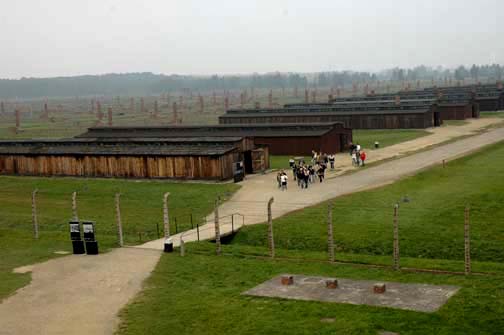 The Quarantine barracks are the first buildings on the north side of the main camp road, located next to the Gate of Death. They have been preserved and can still be seen by tourists today. Some of the new prisoners, who had been selected for labor, (including Elie Wiesel and his father) were sent to the Auschwitz main camp for Quarantine before being sent to the Monowitz labor camp. After the Quarantine period, some of the newcomers were then sent to work at the Auschwitz main camp, or to Monowitz, or to one of the 40 satellite camps or sub-camps. The rest remained at Birkenau where most of the prisoners didn't work. There they lived in squalid conditions in wooden barrack buildings that were intended to be used as horse barns. Since they didn't work, the prisoners at Birkenau were only given enough food to barely keep them alive. Their only activity was standing in line for hours for endless roll calls. The lucky ones were given a job in the camp kitchen or the clothing warehouses at Birkenau where they had the opportunity to steal extra food or clothing for themselves and their friends in the camp. A few of the younger women were assigned to back-breaking work on the experimental farm or to building roads. PreviousAuschwitz III - aka MonowitzMonowitz gas chamber?Liberation of Auschwitz-BirkenauSurvivors of Birkenau campDeath StatisticsHistory of AuschwitzAuschwitz II - aka BirkenauHomeThis page was last updated on February 03, 2010 |